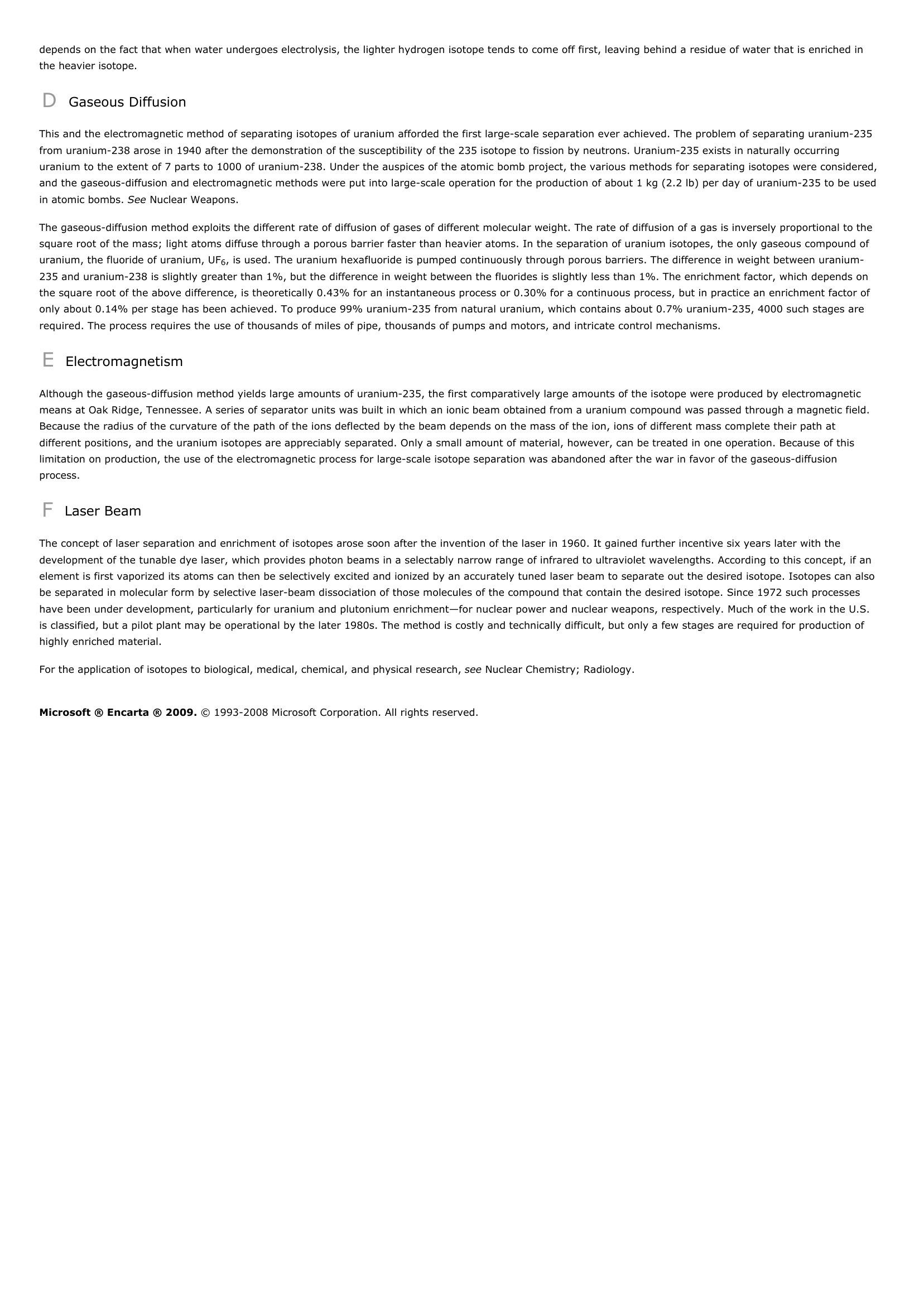Isotope - chemistry.
Publié le 11/05/2013

Extrait du document
«
depends on the fact that when water undergoes electrolysis, the lighter hydrogen isotope tends to come off first, leaving behind a residue of water that is enriched inthe heavier isotope.
D Gaseous Diffusion
This and the electromagnetic method of separating isotopes of uranium afforded the first large-scale separation ever achieved.
The problem of separating uranium-235from uranium-238 arose in 1940 after the demonstration of the susceptibility of the 235 isotope to fission by neutrons.
Uranium-235 exists in naturally occurringuranium to the extent of 7 parts to 1000 of uranium-238.
Under the auspices of the atomic bomb project, the various methods for separating isotopes were considered,and the gaseous-diffusion and electromagnetic methods were put into large-scale operation for the production of about 1 kg (2.2 lb) per day of uranium-235 to be usedin atomic bombs.
See Nuclear Weapons.
The gaseous-diffusion method exploits the different rate of diffusion of gases of different molecular weight.
The rate of diffusion of a gas is inversely proportional to thesquare root of the mass; light atoms diffuse through a porous barrier faster than heavier atoms.
In the separation of uranium isotopes, the only gaseous compound ofuranium, the fluoride of uranium, UF 6, is used.
The uranium hexafluoride is pumped continuously through porous barriers.
The difference in weight between uranium- 235 and uranium-238 is slightly greater than 1%, but the difference in weight between the fluorides is slightly less than 1%.
The enrichment factor, which depends onthe square root of the above difference, is theoretically 0.43% for an instantaneous process or 0.30% for a continuous process, but in practice an enrichment factor ofonly about 0.14% per stage has been achieved.
To produce 99% uranium-235 from natural uranium, which contains about 0.7% uranium-235, 4000 such stages arerequired.
The process requires the use of thousands of miles of pipe, thousands of pumps and motors, and intricate control mechanisms.
E Electromagnetism
Although the gaseous-diffusion method yields large amounts of uranium-235, the first comparatively large amounts of the isotope were produced by electromagneticmeans at Oak Ridge, Tennessee.
A series of separator units was built in which an ionic beam obtained from a uranium compound was passed through a magnetic field.Because the radius of the curvature of the path of the ions deflected by the beam depends on the mass of the ion, ions of different mass complete their path atdifferent positions, and the uranium isotopes are appreciably separated.
Only a small amount of material, however, can be treated in one operation.
Because of thislimitation on production, the use of the electromagnetic process for large-scale isotope separation was abandoned after the war in favor of the gaseous-diffusionprocess.
F Laser Beam
The concept of laser separation and enrichment of isotopes arose soon after the invention of the laser in 1960.
It gained further incentive six years later with thedevelopment of the tunable dye laser, which provides photon beams in a selectably narrow range of infrared to ultraviolet wavelengths.
According to this concept, if anelement is first vaporized its atoms can then be selectively excited and ionized by an accurately tuned laser beam to separate out the desired isotope.
Isotopes can alsobe separated in molecular form by selective laser-beam dissociation of those molecules of the compound that contain the desired isotope.
Since 1972 such processeshave been under development, particularly for uranium and plutonium enrichment—for nuclear power and nuclear weapons, respectively.
Much of the work in the U.S.is classified, but a pilot plant may be operational by the later 1980s.
The method is costly and technically difficult, but only a few stages are required for production ofhighly enriched material.
For the application of isotopes to biological, medical, chemical, and physical research, see Nuclear Chemistry; Radiology.
Microsoft ® Encarta ® 2009. © 1993-2008 Microsoft Corporation.
All rights reserved..
»
↓↓↓ APERÇU DU DOCUMENT ↓↓↓
Liens utiles
- « Life is a self-replicating, evoluing system based on organic chemistry » Qu’est ce qui est vivant ?
- Isotope - Physik.
- Technetium - chemistry.
- Tellurium - chemistry.
- Terbium - chemistry.
















